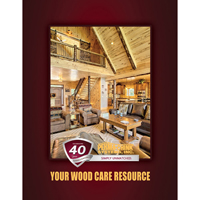 Perma-Chink Systems, Inc
Log & Timber Home Care Experts
Perma-Chink Systems, Inc
Log & Timber Home Care Experts
Hi there, sports fans! Can you believe it is November? Seems to me I was just getting used to summer! Cold weather is coming and it pays to get serious about closing those last few orders and thinking about comfort and home protection over the winter.
You can assure customers by suggesting they've spent their last winter with drafts, cool air, and high energy costs with a properly sealed home. They will be much more comfortable, increase their home value, and protect their log home investment by chinking now, before the winter cold sets in.
If the logs themselves could use some additional protection, suggest LIFELINE natural wood finish, which is specifically designed for log homes. LIFELINE is easy to apply, enhances the natural beauty of the logs, and provides premium protection against the ravages of the coming winter.
And for sure note that if you apply LIFELINE finishes to the home now, we assure compatibility with Perma-Chink chinking for later applications. Works great the other way around, too - chink now with Perma-Chink or Energy Seal and follow up with LIFELINE for a dynamite sealant system.
Q: I am always pressed for time, how soon after LIFELINE application can I apply Perma-Chink?
A: LIFELINE will dry to the touch in an hour or so, and Perma-Chink can easily be applied the following day.
The Difference is Clear, but it’s NOT What You Think.
It makes sense that the more your product costs, the higher the quality of ingredients.
To prove this point, the professionals in the industry performed a careful analysis that shows that in the long run, it’s less expensive to apply the very best quality stain, despite its higher initial cost.
How Does a Low-Cost Option Cost More?
Field tests show that while low-quality finishes last two years or less, top-quality, 100-percent acrylic polymer finishes such as the Lifeline™ Ultra family from Perma-Chink Systems last five years or more when applied to a properly prepared surface and maintained on a regular basis.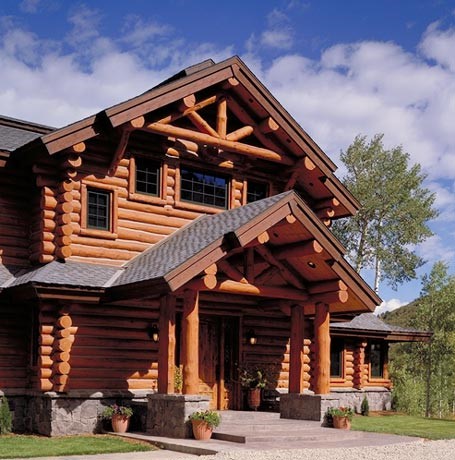
CHEMIST'S CORNER: Can All Wood Species Be Prepared the Same Way, Using the Same Cleaning Products?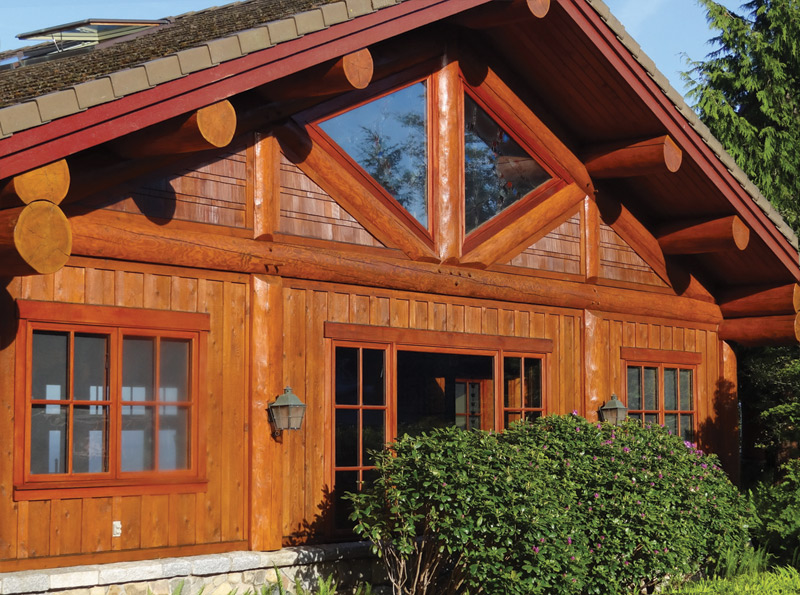
The obvious answer to this question is NO. Although all wood species contain many of the same components - including cellulose and hemicellulose and minor amounts of extraneous materials - it is the wood extractives that differentiate wood species from one another.
How to Use Deck Defense™ and Log & Timber Defense™ Products
Proper treatment and care of your horizontal and vertical structures can add beauty and longevity to your entire living space. To help seal and protect your deck, fences, or railings we recommend using our waterborne finish Deck Defense. For vertical structures such as wood siding, trim, timberframe, beams, and rough-cut cedar we recommend Log & Timber Defense.
Defense products work by penetrating several layers deep into the wood fibers creating a lattice network that strengthen and protect your wood from the inside out. These products are formulatedfor better performance, longer life, easier application, and upkeep. They also will not flake or peel when applied according to labeled instructions.
All structures should have a surface moisture less than 20% before applying a Defense product. High moisture content will hinder the penetration and adhesion of the finish. If constructing a new deck, boards should be placed bark side down. Also, if the boards have a high moisture content, they should be placed in direct contact with one another when laid down. As the boards dry a gap will open for proper airflow and drainage. If you gap them when they are too wet, the gaps between the boards will likely be too large. Having to estimate what the final gap will be, can be avoided if moisture equilibrated kiln dried boards are used. Finally, let the new boards season for several months prior to application of a finish. This will allow time for the wood to shrink completely and come to an equilibrium with its environment.
Wood Preparation
In situations where a Defense product is going to be applied on an established deck, the deck must be free of the existing finish, in addition to being clean and dry. The cleaning solution required depends on the condition of the boards.
Log Wash™ is an excellent wood cleaner to remove dirt, grime, pollen and surface stains from bare wood (use two cups per gallon of water).
Cedar Wash™ is a ready to use cleaner designed specifically for wood with high extractives content such as Southern Pine, Spruce, Douglas Fir and Cyprus wood.
Wood Renew™ is used when the wood surfaces have been damaged. i.e., grayed wood and mill glaze. It will restore the wood back to its natural color. Wood Renew is also the preferred method for preparing deck boards for staining. It is important to follow all labeled instructions when using this product.
Sanding is used to remove surface imperfections. Although labor intensive, sanding helps to increase mechanical adhesion, provides for better color uniformity and aids in opening the substrate to promote better penetration of the stain. 40 – 60 grit sandpaper is recommended for decks. Always sand in the direction of the grain. When finished with the sanding, clean the surface using our Log Wash solution.
Finish Removers are used to remove an existing finish. There are two relatively safe waterborne finish removers designed to soften the finish so that it can be removed mechanically using a pressure washer.
(1) S-100™: Is supplied as a ready to use high pH gel. The gel helps it to remain active for an extended period.
(2) Strip It®: Is supplied as a ready to use pH neutral finish remover. It is designed to remove multiple layers of finish at a time.
We recommend that you obtain samples of each and test both to determine which works best for removing your finish. Follow all labeled instructions.
Rinsing is very important to completely remove the cleaning solution and debris. Use pH strips to test the rinse water run off to make sure the rinse water is between 6.5 – 7.5. Inadequate rinsing will lead to unnecessary problems and shorten the life of the stain. After rinsing allow the surface to completely dry before application of a finish.
Application Guidelines
• Surface Preparation: Must be applied to clean, dry surface.
• Application Weather Consideration: Do not apply if rain is eminent within 6 hours.
• Personal Protective Equipment: Although Defense products are considered non-toxic, gloves are recommended when applying.
• Protect from overspray: Wet down and cover nearby vegetation and adjacent surfaces. Keep these areas wet during application and rinse promptly when finished.
• Mixing: Mix thoroughly initially and every 15 min. to ensure color uniformity. Do not use powered mixing equipment.
• Boxing: We recommend boxing pails together if using different batch numbers. This will help with uniform color.
• Application Methods: Low-pressure pump-up sprayer, Paint Pads (for deck application), quality brush, or roller. Apply in a flooding manner to completely cover the surface of the wood, allowing the product to soak into the wood. Back-brush the finish into the wood using a quality brush.
• Maintain a wet edge: Work in small sections to help maintain a wet edge. This will help prevent lap marks.
• Work in the same direction: When applying the finish apply in the direction of the grain and stop only at natural breaks such as board ends to prevent lap marks.
• Application Surface Temperature: 40 – 90 degrees Fahrenheit:
• Number of Coats: Defense products works great as a one coat stain. However, for color or if the surface appears blotchy, a second coat may be applied. The second coat should be applied wet on wet. If it is not, wait one week before application of a second coat.
• Drying Times: Drying times will vary with application, airflow temperature and humidity. Under ideal conditions Defense Products will dry to the touch in 20-30 minutes. For horizontal surfaces wait 4 - 6 hours before walking on the surface and 24 hours before replacing heavy furniture.
• Coverage Rates: Coverage rates will vary considerably based on the type of substrate and methods of application. A second coat will require much less. Below are some approximations of coverage rates based on the type of wood.
• Rough Sawn Wood: Rough sawn wood such as fences will soak up a large amount of stain. Perhaps as low as 100 – 175 ft2 per gallon
• Older mature decks: 175 – 250 ft2 per gallon
• New Wood: 250 – 300 ft2 per gallon
• Protect from Freezing: Although freeze thaw stable, this will ensure any possibility of degradation.
Clean Up
If cleaned soon after application, tools and equipment are easily cleaned with soap and warm water. Dispose of unused product in accordance with local, state and federal guidelines.
Maintenance
Good maintenance for decks as well as for other wood surfaces will prolong the need for re-staining or removal. Defense products will not flake or peel when properly applied. Clean with log wash when needed. We recommend using one cup concentrated log wash per gallon water. Expect to see more wear in high traffic areas such as steps and traffic patterns. These areas can be recoated easily where needed after cleaning with log wash. We discourage using a clear topcoat over Defense products. A topcoat will prevent any future recoating.
When it comes to using elastomeric sealants, considering the potential movement of your wood is almost always a smart move. Some important factors to consider that impact wood movement are moisture content, species type, type of cut (flat tangential cut or quarter sawn radial cut) and local environmental conditions. Not taking these into account has the potential to lead to costly repairs in the future.

There is no secret in retaining the beauty of your log home. A little care and maintenance along with the use of quality products designed specifically for log homes will keep your home looking great for generations to come.
CARING FOR YOUR DREAM HOME
The proper application of preservatives, stains and finishes is equally important as the prep work to the wood.
NEW LOG HOMES
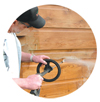 STEP 1 - SURFACE PREP
STEP 1 - SURFACE PREP
With this in mind we have decided that the ONLY cleaning products approved for use with our finishes are those products supplied or recommended by Perma-Chink Systems, Inc.
- If the wood has not grayed, wash the surface with Log Wash™ solution and a pressure washer no more than seven (7) days prior to staining. Rinse well and allow the wood to dry.
- If you are finishing Western Red Cedar, Redwood, Walnut or Mahogany, use Cedar Wash™, a ready-to-use cleaner, instead of Log Wash for better surface preparation and finish longevity on these specific wood substrates.
- If there are signs of grayed wood, use Wood ReNew according to the label along with a pressure washer. Rinse well and allow wood surface to dry before staining.
- If after washing there are still dark streaks or discolorations, use a solution of Oxcon™ on the entire wall. Rinse well and allow the wood to dry before staining.
Resources:
Download Cleaning Guide in pdf
View All Wood Cleaning Products here
 STEP 2 - PRESERVE
STEP 2 - PRESERVE
Special purpose preservatives to protect against termites, insects, wood rot, mold and mildew.
Resources:
View All Wood Preservatives Products here
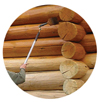 STEP 3 - STAIN and FINISH
STEP 3 - STAIN and FINISH
Finishes to protect and bring the beauty of your exterior and interior walls, decks and floors.
Resources:
Stains and Finishes Application Guide
Staining and Finishing Tech Tips
View All Stain and Finishes Products here
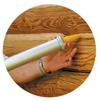 STEP 4 - SEAL and CHINK
STEP 4 - SEAL and CHINK
Flexible sealants for every weather-proofing job around your chinked or chinkless style log home.
Resources:
Sealing and Chinking Tech Tips
View All Sealants and Chinking Products here
MAINTENANCE for EXISTING LOG HOMES
Check for weathering patterns that can include:
- Fading of the finish.
To test your finish or stain, use a spray bottle to mist the logs with water. If the water beads up and runs off like a freshly waxed care, then it’s doing it’s job. If logs soak up water, then you’ll need another application of finish.
- Water staining on exposed log ends.
If you have exposed timbers on the underside of your eaves that extend flush with the overhang or protrude past it, the ends of these logs are susceptible to rot. Treat with Shell-Guard then sand and seal with Log End Seal.
- Water staining on exposed walls.
Check flashing around the windows to ensure that all water is being channeled out and down the exterior walls. Water stains of the logs or drafts around the windows or doors indicate that air and water is infiltrating your home. The right sealant is the solution for this problem.
Download Inspection Checklist here
Log and Timber Home Maintenance in Details here
Log Homes with an Existing Finish That is Still in Good Condition
If a maintenance coat of Lifeline stain or topcoat is going to be applied over an existing Lifeline finish, wash the coating surface with Log Wash solution no more than seven (7) days prior to staining. Rinse well and allow the wood to dry, then apply a fresh coat of stain or finish.
Still have questions, call us 1-800-548-3554 or chat with us on permachink.com
Check for Log Home Contractors Near You 
ORDER OUR FREE PRODUCT CATALOG
Perma-Chink Systems® has recently added another beautiful wood finish option for our customers. Unlike our traditional Lifeline film-forming wood finishes, Log & Timber Defense™ penetrates your wood. As it absorbs into the wood surface, it forms a strong lattice network within the wood, reinforcing and strengthening the entire system from the inside out. Due to its elastomeric nature and penetration, it greatly reduces the chances of peeling and flaking by leaving the system breathable to water vapor. Many penetrating oil-based finishes can also form a network but unfortunately often contain harmful flammable solvents that make working with them both dangerous for you and our environment. In contrast our Log & Timber Defense is water-based making it both easier and safer to work with.
Perma-Chink Systems® recently added another beautiful wood finish option for our customers - Log and Timber Defense™. Unlike our traditional Lifeline wood finishes, Log and Timber Defense penetrates your wood much like an oil coating. Once Log and Timber Defense penetrates the wood surface, it forms a strong lattice network within the wood, reinforcing and strengthening the entire system from the inside out. This mechanism greatly reduces the chances of peeling and flaking by leaving the system breathable to water vapor. Many traditional oil-based finishes can also form a network, but are often so high in solids that they can easily blister and peel. Vapor pressure builds up behind the thick, unbreathable solid film and pushes the film away from the wood. This leads to an unfortunate situation requiring removal of the compromised coating down to bare wood.
By Jared Turner
We often get asked this very question. To help answer this we must look to our experience both past and present. For 40 years now Perma-Chink Systems® has been working to develop products that meet both the demands of Nature and our Customers. The result of this experience has been a wide range of products that help solve specific needs. Our wood finishes can be split into four main categories: exterior film forming, exterior penetrating, interior film forming and specialty. Let us take a closer look at these products and discover what makes each one unique.
Designing a Fortress of Protection for Your Log Home
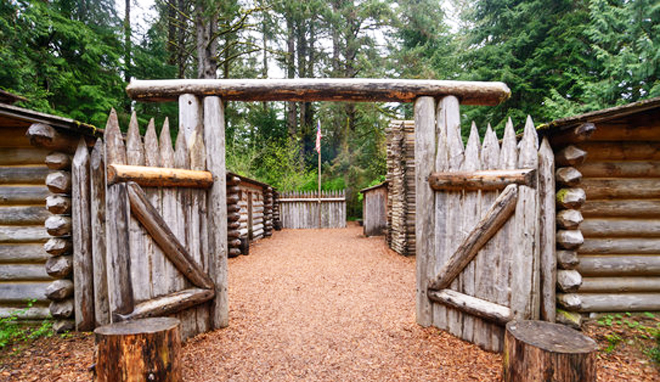
When I was growing up, I was fascinated with forts. I would often get together with friends from the neighborhood, and we would combine our resources and construct some rather elaborate fortresses. To test our handywork we would end our session with a great battle to decide whose fort was superior. Fast forward nearly forty years and I am still helping design forts! At Perma-Chink Systems the forts we are building are designed to protect your home against the forces of nature such as sunlight, wind, rain, dust, insects and microorganisms. Let us take a closer look at what our fort looks like.
